MENU
The Electronic Scholarly Publishing Project: Providing access to classic scientific papers and other scholarly materials, since 1993. More About: ESP | OUR CONTENT | THIS WEBSITE | WHAT'S NEW | WHAT'S HOT
Comparative Timelines
The ESP Timeline (one of the site's most popular features) has been completely updated to allow the user to select (using the timeline controls above each column) different topics for the left and right sides of the display.
Select:
New Left Column
New Left Column
Dates
Decade
New Right Column
New Right Column
For the first time, women began to act in plays in London. Previously men had portrayed both male and female roles.
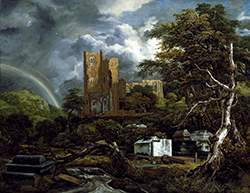 Painting by Jacob von Ruisdale: The Jewish Cemetery is an oil on canvas painting. It is an example of Dutch Golden Age painting and is now in the collection of the Detroit Institute of Arts. This painting was documented by John Smith in 1835, who wrote: "This grand and affecting picture exhibits the ruins of a church and convent upon the summit of a hill, occupying the whole extent of the view in the second distance, the declivity of which presents a cemetery, interspersed with large stones. On the foreground are a broken tree lying across a rapid stream, a tomb of black marble, with an inscription on it; a row of three sarcophagi extending along the front; and on the left stands a cluster of large umbrageous trees, the verdant hues of whose foliage is contrasted by the leafless trunk of a beech. Three persons in black are seen near a small tomb on the side of the hill, musing amidst the tombs. The grandeur and solemnity of the scene is strikingly enhanced by rolling stormy clouds, in which may be perceived the evanescent colours of a rainbow.
Painting by Jacob von Ruisdale: The Jewish Cemetery is an oil on canvas painting. It is an example of Dutch Golden Age painting and is now in the collection of the Detroit Institute of Arts. This painting was documented by John Smith in 1835, who wrote: "This grand and affecting picture exhibits the ruins of a church and convent upon the summit of a hill, occupying the whole extent of the view in the second distance, the declivity of which presents a cemetery, interspersed with large stones. On the foreground are a broken tree lying across a rapid stream, a tomb of black marble, with an inscription on it; a row of three sarcophagi extending along the front; and on the left stands a cluster of large umbrageous trees, the verdant hues of whose foliage is contrasted by the leafless trunk of a beech. Three persons in black are seen near a small tomb on the side of the hill, musing amidst the tombs. The grandeur and solemnity of the scene is strikingly enhanced by rolling stormy clouds, in which may be perceived the evanescent colours of a rainbow.
1660
(no entry for this year)
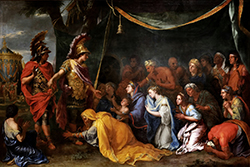 Painting by Charles Le Brun: The Family of Darius Before Alexander represents the scene when the Queen of Persia is kneeling at the feet of Alexander the Great.
Painting by Charles Le Brun: The Family of Darius Before Alexander represents the scene when the Queen of Persia is kneeling at the feet of Alexander the Great.
1661
(no entry for this year)
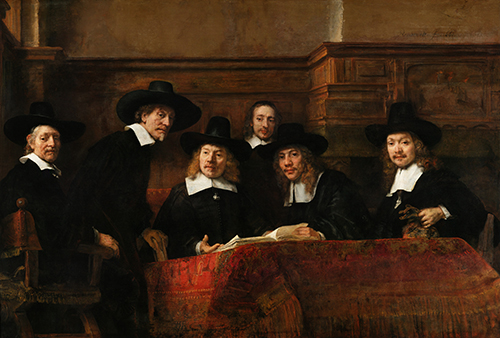 Painting by Rembrandt: The Syndics of the Drapers Guild has been described as Rembrandt's "last great collective portrait". The men (with the exception of Bel who is an attendant as indicated by his calotte) are drapers who were elected to assess the quality of cloth that weavers offered for sale to members of their guild. Their one-year terms in office began on Good Friday and they were expected to conduct their inspections thrice weekly. The Dutch word staal means 'sample' and refers to the samples of cloth that were assessed. The inspectors used pliers to press the seals of their city (front) and guild (reverse) into penny-sized slugs of lead that were specially affixed to record the results of the inspection. There were four grades of quality, the highest was indicated by pressing four seals and the lowest by pressing only one. The men, who are appraising a length of Persian-style fabric against exemplars from a swatch book, are (from left to right): Jacob van Loon, Volckert Jansz, Willem van Doeyenburg, Frans Hendricksz Bel, Jochem de Neve, and Aernout van der Mye. The guild commissioned this portrait and it hung in their guildhall, the Staalhof, until 1771. The painting is used on the packaging of Dutch Masters cigars.
Painting by Rembrandt: The Syndics of the Drapers Guild has been described as Rembrandt's "last great collective portrait". The men (with the exception of Bel who is an attendant as indicated by his calotte) are drapers who were elected to assess the quality of cloth that weavers offered for sale to members of their guild. Their one-year terms in office began on Good Friday and they were expected to conduct their inspections thrice weekly. The Dutch word staal means 'sample' and refers to the samples of cloth that were assessed. The inspectors used pliers to press the seals of their city (front) and guild (reverse) into penny-sized slugs of lead that were specially affixed to record the results of the inspection. There were four grades of quality, the highest was indicated by pressing four seals and the lowest by pressing only one. The men, who are appraising a length of Persian-style fabric against exemplars from a swatch book, are (from left to right): Jacob van Loon, Volckert Jansz, Willem van Doeyenburg, Frans Hendricksz Bel, Jochem de Neve, and Aernout van der Mye. The guild commissioned this portrait and it hung in their guildhall, the Staalhof, until 1771. The painting is used on the packaging of Dutch Masters cigars.
1662
(no entry for this year)
(no entry for this year)
1663
(no entry for this year)
 Painting by Frans Hals The Governors of the Almshouse is a regents' group portrait of five regents and their servant painted by Frans Hals in 1664 for the Oude Mannenhuis in Haarlem, the Netherlands. It forms a pendant with the Regentesses of the Old Men's Almshouse. Though it is no longer known which name belongs with which face, the regents portrayed were Jonas de Jong, Mattheus Everzwijn, dr. Cornelis Westerloo, Daniel Deinoot and Johannes Walles. Frans Hals painted them in his "loose style", with rough brush strokes. The painting is traditionally dated 1664, though no archival evidence has yet been found to confirm this. The date is chosen as the middle of the term that the sitters served as regents. Though the paintings as pendants seem to belong together, they did not hang together, and as was the case in the St. Elisabeth hospital across the street, they probably each hung in a separate regents' meeting room; the one for the ladies in the ladies' meeting room and the one for the men in the men's meeting room.
Painting by Frans Hals The Governors of the Almshouse is a regents' group portrait of five regents and their servant painted by Frans Hals in 1664 for the Oude Mannenhuis in Haarlem, the Netherlands. It forms a pendant with the Regentesses of the Old Men's Almshouse. Though it is no longer known which name belongs with which face, the regents portrayed were Jonas de Jong, Mattheus Everzwijn, dr. Cornelis Westerloo, Daniel Deinoot and Johannes Walles. Frans Hals painted them in his "loose style", with rough brush strokes. The painting is traditionally dated 1664, though no archival evidence has yet been found to confirm this. The date is chosen as the middle of the term that the sitters served as regents. Though the paintings as pendants seem to belong together, they did not hang together, and as was the case in the St. Elisabeth hospital across the street, they probably each hung in a separate regents' meeting room; the one for the ladies in the ladies' meeting room and the one for the men in the men's meeting room.
1664
(no entry for this year)
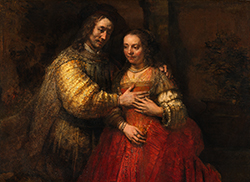 Painting by Rembrandt: The Jewish Bride gained its current name in the early 19th century, when an Amsterdam art collector identified the subject as that of a Jewish father bestowing a necklace upon his daughter on her wedding day. This interpretation is no longer accepted, and the identity of the couple is uncertain. The ambiguity is heightened by the lack of anecdotal context, leaving only the central universal theme, that of a couple joined in love. Speculative suggestions as to the couple's identity have ranged from Rembrandt's son Titus and his bride, or Amsterdam poet Miguel de Barrios and his wife. Also considered are several couples from the Old Testament, including Abraham and Sarah, or Boaz and Ruth. The likeliest identification, however, is that of Isaac and Rebekah, as described in Genesis 26:8, and is supported by a drawing by the artist of the same theme.
Painting by Rembrandt: The Jewish Bride gained its current name in the early 19th century, when an Amsterdam art collector identified the subject as that of a Jewish father bestowing a necklace upon his daughter on her wedding day. This interpretation is no longer accepted, and the identity of the couple is uncertain. The ambiguity is heightened by the lack of anecdotal context, leaving only the central universal theme, that of a couple joined in love. Speculative suggestions as to the couple's identity have ranged from Rembrandt's son Titus and his bride, or Amsterdam poet Miguel de Barrios and his wife. Also considered are several couples from the Old Testament, including Abraham and Sarah, or Boaz and Ruth. The likeliest identification, however, is that of Isaac and Rebekah, as described in Genesis 26:8, and is supported by a drawing by the artist of the same theme.
1665
(no entry for this year)
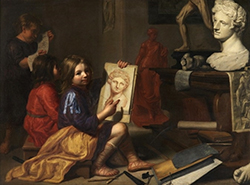 Painting by Jacob van Oost: The Painter's Studio, an allegory of the academic doctrine of beauty, in which the example of Classical Antiquity and draftsmanship were central. It is signed and dated lower right.
Painting by Jacob van Oost: The Painter's Studio, an allegory of the academic doctrine of beauty, in which the example of Classical Antiquity and draftsmanship were central. It is signed and dated lower right.
1666
Samuel Morland builds a mechanical calculator that will add and subtract
Milton's Paradise Lost is published.
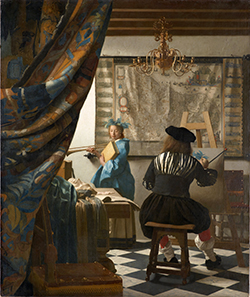 Painting by Jan Vermeer: The Art of Painting is one of Vermeer's most famous. In 1868 Thoré-Bürger, known today for his rediscovery of the work of painter Johannes Vermeer, regarded this painting as his most interesting. Svetlana Alpers describes it as unique and ambitious; Walter Liedtke "as a virtuoso display of the artist's power of invention and execution, staged in an imaginary version of his studio ..." According to Albert Blankert "No other painting so flawlessly integrates naturalistic technique, brightly illuminated space, and a complexly integrated composition." Many art historians think that it is an allegory of painting, hence the alternative title of the painting. Its composition and iconography make it the most complex Vermeer work of all.
Painting by Jan Vermeer: The Art of Painting is one of Vermeer's most famous. In 1868 Thoré-Bürger, known today for his rediscovery of the work of painter Johannes Vermeer, regarded this painting as his most interesting. Svetlana Alpers describes it as unique and ambitious; Walter Liedtke "as a virtuoso display of the artist's power of invention and execution, staged in an imaginary version of his studio ..." According to Albert Blankert "No other painting so flawlessly integrates naturalistic technique, brightly illuminated space, and a complexly integrated composition." Many art historians think that it is an allegory of painting, hence the alternative title of the painting. Its composition and iconography make it the most complex Vermeer work of all.
1667
(no entry for this year)
(no entry for this year)
1668
(no entry for this year)
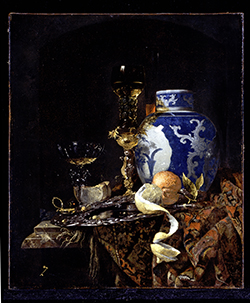 Painting by Willem Kalf: Still Life with a Chinese Porcelain Jar is a sumptuous still life displaying the sort of costly wares that flowed through the Netherlands during its heyday as a trade center. In Still Life with a Chinese Porcelain Jar, Kalf selected an array of precious objects with which to showcase the wealth and refinement of the Netherlands and his own skills as a painter. Everything is expensive, imported, or both. The citrus fruit, glassware from Venice, and Chinese porcelain jar are evidence of Dutch sailors' enterprise. Local talent is displayed by Dutch silver and a rummer, or wineglass, with a cherub holding a cornucopia at its base. They stand on a marble tabletop with a carelessly crumpled oriental rug. Amid all that luxury is a lesson: a ticking watch on the silver platter reminds the viewer that such earthly riches are fleeting, and worth far less than eternal salvation. The carefully balanced composition, rich colors, and warm tonalities make this painting an object of beauty as well as moral edification.
Painting by Willem Kalf: Still Life with a Chinese Porcelain Jar is a sumptuous still life displaying the sort of costly wares that flowed through the Netherlands during its heyday as a trade center. In Still Life with a Chinese Porcelain Jar, Kalf selected an array of precious objects with which to showcase the wealth and refinement of the Netherlands and his own skills as a painter. Everything is expensive, imported, or both. The citrus fruit, glassware from Venice, and Chinese porcelain jar are evidence of Dutch sailors' enterprise. Local talent is displayed by Dutch silver and a rummer, or wineglass, with a cherub holding a cornucopia at its base. They stand on a marble tabletop with a carelessly crumpled oriental rug. Amid all that luxury is a lesson: a ticking watch on the silver platter reminds the viewer that such earthly riches are fleeting, and worth far less than eternal salvation. The carefully balanced composition, rich colors, and warm tonalities make this painting an object of beauty as well as moral edification.
1669
(no entry for this year)
ESP Quick Facts
ESP Origins
In the early 1990's, Robert Robbins was a faculty member at Johns Hopkins, where he directed the informatics core of GDB — the human gene-mapping database of the international human genome project. To share papers with colleagues around the world, he set up a small paper-sharing section on his personal web page. This small project evolved into The Electronic Scholarly Publishing Project.
ESP Support
In 1995, Robbins became the VP/IT of the Fred Hutchinson Cancer Research Center in Seattle, WA. Soon after arriving in Seattle, Robbins secured funding, through the ELSI component of the US Human Genome Project, to create the original ESP.ORG web site, with the formal goal of providing free, world-wide access to the literature of classical genetics.
ESP Rationale
Although the methods of molecular biology can seem almost magical to the uninitiated, the original techniques of classical genetics are readily appreciated by one and all: cross individuals that differ in some inherited trait, collect all of the progeny, score their attributes, and propose mechanisms to explain the patterns of inheritance observed.
ESP Goal
In reading the early works of classical genetics, one is drawn, almost inexorably, into ever more complex models, until molecular explanations begin to seem both necessary and natural. At that point, the tools for understanding genome research are at hand. Assisting readers reach this point was the original goal of The Electronic Scholarly Publishing Project.
ESP Usage
Usage of the site grew rapidly and has remained high. Faculty began to use the site for their assigned readings. Other on-line publishers, ranging from The New York Times to Nature referenced ESP materials in their own publications. Nobel laureates (e.g., Joshua Lederberg) regularly used the site and even wrote to suggest changes and improvements.
ESP Content
When the site began, no journals were making their early content available in digital format. As a result, ESP was obliged to digitize classic literature before it could be made available. For many important papers — such as Mendel's original paper or the first genetic map — ESP had to produce entirely new typeset versions of the works, if they were to be available in a high-quality format.
ESP Help
Early support from the DOE component of the Human Genome Project was critically important for getting the ESP project on a firm foundation. Since that funding ended (nearly 20 years ago), the project has been operated as a purely volunteer effort. Anyone wishing to assist in these efforts should send an email to Robbins.
ESP Plans
With the development of methods for adding typeset side notes to PDF files, the ESP project now plans to add annotated versions of some classical papers to its holdings. We also plan to add new reference and pedagogical material. We have already started providing regularly updated, comprehensive bibliographies to the ESP.ORG site.
ESP Picks from Around the Web (updated 06 MAR 2017 )
Old Science

Weird Science

Treating Disease with Fecal Transplantation
Fossils of miniature humans (hobbits) discovered in Indonesia

Dinosaur tail, complete with feathers, found preserved in amber.
Astronomy

Mysterious fast radio burst (FRB) detected in the distant universe.